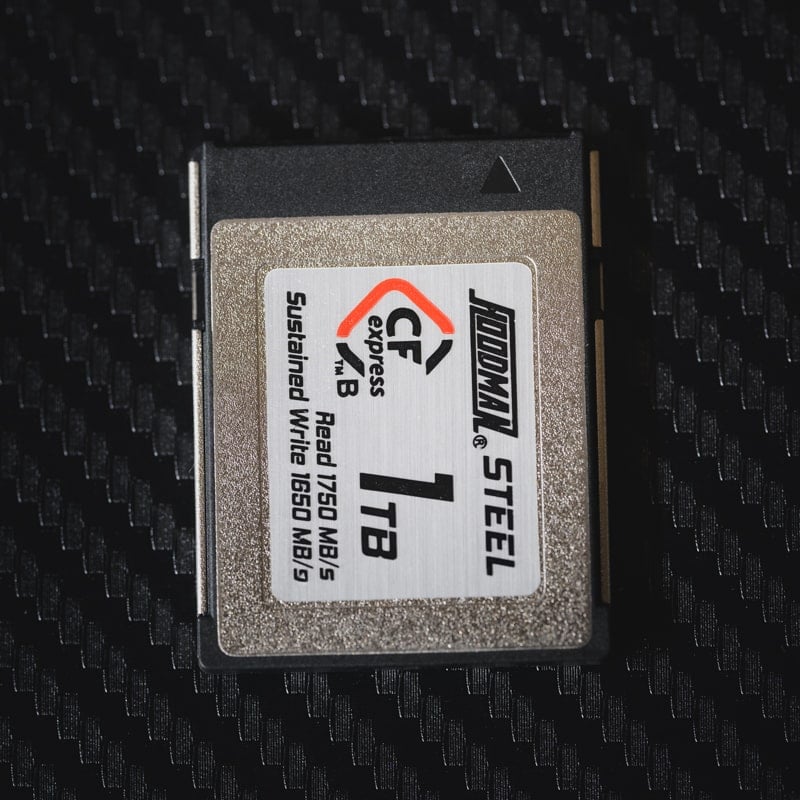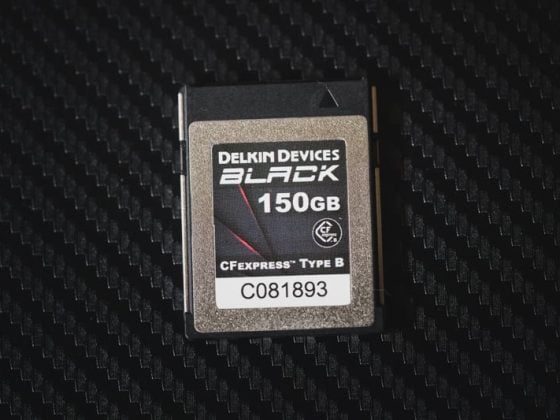The Hoodman Steel CFexpress Type-B Series strikes a great balance between speed and affordability. With read speeds of up to 1750MB/s and write speeds of 1650MB/s, it handles high-resolution images and video smoothly with a 1650MB/s sustain speed.
Hoodman Steel 1TB CFexpress Type-B

Hoodman Steel 1TB CFexpress Type B cards have a rated write speed of 1650MB/s and a rated read speed of 1750MB/s.
Tested Write Speed: 1528MB/s
Tested Read Speed: 1121MB/s
Tested Sustain: 1502 MB/s
Warranty: Limited Lifetime – Learn more at HoodmanUSA
Key Features:
- Capacity: Available in 1TB
- Read Speed: Up to 1750 MB/s
- Write Speed: Up to 1650 MB/s
- Sustained Speeds: 1650 MB/s
- Bus Type: PCI-Express 3.0
Note: With CFexpress memory cards, different sizes don’t always have the same specs. The 1TB Hoodman Steel card is faster than the 512GB card. Be sure to check the specs of the 512GB card if you decide to go with the lower-capacity card.
Benchmarks – USB-C Speed Tests.
I utilize the AJA System Test to emulate various video codec types. Currently, I’m working with 16-bit RGBA. I conduct multiple tests with a 4GB file size and record the highest scores. For determining the actual sustained speed, I perform several tests with a 64GB file size and note the lowest speed after several cycles.
The reader I used was the AngelBird USB 3.2 2×2 CFExpress Type-B reader. I also tried a Prograde USB 3.2 2×2 reader which limited the card to around 900-1000MB/s, but the Angelbird gave me the speeds you see here. With different USB-C readers, the read and write speeds do show varying results, which is not uncommon. I wasn’t able to get the rated read speeds with my readers, but 1,121MB/s still wasn’t bad.
| Card Tested | Write Speed | Read Speed | Sustain Speeds |
| Hoodman Steel CFxB 1TB | 1528 MB/s | 1121 MB/s | 1502 MB/s |
Tested sustain speeds at 1502MB/s perform very close to the write speeds which is great for video, especially when shooting very high bitrates like the Internal RAW on Nikon or RED cameras.
When testing the 1TB Hoodman Steel card for the Nikon Z8 Memory Cards Speed Tests, in-camera write speeds came in at 614MB/s, which is great considering the price compared to bigger brands like Lexar or Delkin. By comparison, the Delkin Black ran at 700MB/s but is more than twice as expensive when comparing equal capacity.
I want to point out that when I do in-camera tests I can only get the buffer results from images shot in sequence. Each image requires processing so what we see is a slower write speed than what the cards are doing in-camera. NRAW for example runs at 722.5MB/s but the camera speeds in my buffer tests bottleneck at around 700MB/s.
I’ve been able to run NRAW recordings in the Nikon Z8 continuously and fill up this card without any problems, which means the card is actually running faster than 614MB/s. Some additional compression or something was happening with the scene I was shooting for this recent test on the Hoodman Card compared to my tests with the other cards since I did not retest everything in the same setting (the background had red carpet instead of a white carpet from previous tests). So possibly there was more information in the scene causing a heavier load on the compression making us hit a processor bottleneck.
I did test the GFX100 II with all the same scenes with all the cards and I’ll post those results soon.
Sustained Disk Writes
While we don’t have an official VGP-400 rating, meaning a guaranteed minimum sustained speed of 400MB/s, I’m seeing very consistent results even after doing multiple tests and using this card in my Nikon Z8 for several months.
In the chart below using AJA System Test, the peak write speed hit around 1,532GB/s, and throughout the 64GB write cycle, it never dropped. I’ve done this test several times in a row and still don’t see a performance drop which is incredible considering how this card is positioned in the market.

Compatibility:
Designed specifically for CFexpress Type-B cameras, like the Nikon Z8 or the Fujifilm X-H2s, this card can handle anything you throw at it with today’s cameras. NRAW, REDRAW high bitrate H.265, or even ProRes HQ.
Compare to other CFepxress Type-B memory cards.
Durability:
Hoodman Steel memory cards are rugged cards and have reinforced builds. While this doesn’t seem very important considering the card will spend most of its life in camera, I have had memory cards in the past break due to the plastic weakening over the years.
If you want a card that will last for years, rugged cards by Hoodman are a solid option.
B&H listed -13 to 185°F as the operating temperatures, but I believe this should be the storage temperatures as 32 to 102°F is the standard for operating temperatures with all the CFexpress cards.
Operating Temperature: 32 to 102°F / 0 to 70°C
Storage Temperature: -13 to 185°F / -25 to 85°C
Conclusion:
For photographers using cameras that require CFexpress type B memory cards, the Hoodman Steel series of CFexpress Type B cards provides a cost-effective solution. Whether you’re capturing stills or recording video, this 1TB card won’t disappoint.
| **This website contains affiliate links. We will earn a small commission on purchases made through these links. Some of the links used in these articles will direct you to Amazon. As an Amazon Associate, I earn from qualifying purchases. |






